Gujarat Board GSEB Textbook Solutions Class 11 Maths Chapter 5 Complex Numbers and Quadratic Equations Miscellaneous Exercise Textbook Questions and Answers.
Gujarat Board Textbook Solutions Class 11 Maths Chapter 5 Complex Numbers and Quadratic Equations Miscellaneous Exercise
Question 1.
Evaluate [i18 + (\(\frac{1}{i}\))25]3.
Solution:
\(\frac{1}{i}\) = \(\frac{1}{i}\) × \(\frac{i}{i}\) = \(\frac{i}{i^{2}}\) = \(\frac{i}{- 1}\) = – i.
∴ [i18 + (\(\frac{1}{i}\))25]3 = [i18 + (- i)25]3 = [(i2)9 – i(i2)12]3
= [(- 1)9 – i( – 1)12]3
= [- 1 – i]3
= (- 1)3 + 3(- 1)2.(- i) + 3(- 1)(- i)2 + (- i)3
[∵ (a + b)3 = a3 + 3a2b + 3cb2 + b3]
= – 1 – 3i + 3 – i3
= – 1 – 3i + 3 – i(- 1)
= – 1 – 3i + 3 + i = 2 – 2i.
![]()
Question 2.
For any two complex numbers z1 and z2, prove that Re(z1z2) = Rez1 Rez2 – Imz1 Imz2.
Solution:
Let z1 = a + ib, where a – Rez1; b = Im(Z1)
and z2 = c + id, where c – R(z2), d – Im(z2).
∴ z1z2 = (a + ib)(c + id) = ac – bd + i(ad + bc)
∴ Re(z1z2) = ac – bd
= Rez1. Rez2 – Imz1Imz2.
Question 3.
Reduce (\(\frac{1}{1 – 4i}\) – \(\frac{2}{1 + i}\)) (\(\frac{3 – 4i}{5 + i}\)) to the standard form.
Solution:
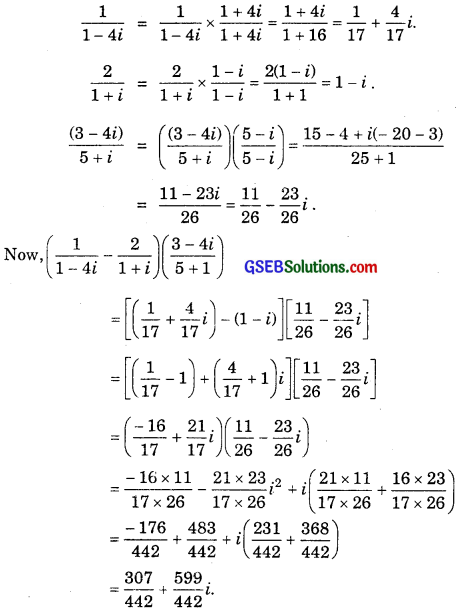
![]()
Question 4.
If x – iy = \(\sqrt{\frac{a-i}{a+i b}}\), prove that (x2 + y2)2 = \(\frac{a^{2}+b^{2}}{c^{2}+d^{2}}\)
Solution:
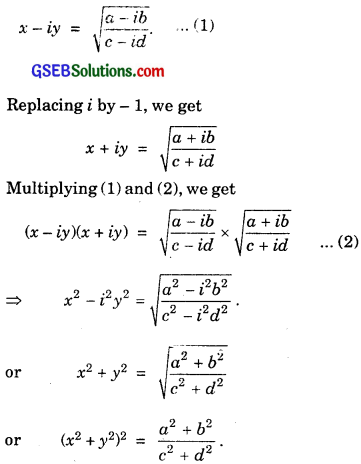
Question 5.
Convert the following in the polar form:
(i) \(\frac{1+7 i}{(2-i)^{2}}\)
(ii) \(\frac{1 + 3i}{1 – 2i}\)
Solution:
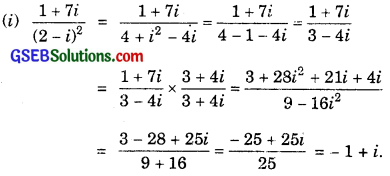
Put rcos θ = – 1 and rsin θ = 1.
Squaring and adding, we get
r2 = 1 + 1 = 2 ⇒ r = \(\sqrt{2}\).
and cos θ = \(\frac{1}{\sqrt{2}}\), sin θ = \(\frac{1}{\sqrt{2}}\).
sin θ is + ve cos θ is – ve. Therefore, θ lies in II quadrant.
So, θ = π – \(\frac{π}{4}\) = \(\frac{3π}{4}\) [∵ sin θ = sin \(\frac{3π}{4}\) = \(\frac{1}{\sqrt{2}}\)]
∴ Polar form of \(\frac{1+7 i}{(2-i)^{2}}\) = \(\sqrt{2}\)(cos \(\frac{3π}{4}\) + isin \(\frac{3π}{4}\))

![]()
Solve each of the equations in questions 6 to 9:
6. 3x2 – 4x + \(\frac{20}{3}\) = 0
7. x2 – 2x + \(\frac{3}{2}\) = 0
8. 27x2 – 10x + 1 = 0
9. 21x2 – 28x + 10 = 0
Solutions to questions 6 to 9:
6. 3x2 – 4x + \(\frac{20}{3}\) = 0
Multiplying by 3, we get
9x2 – 12x + 20 = 0.
∴ a = 9, b = – 12, c = 20.
∴ b2 – 4ac = (- 12)2 – 4.9.20 = 144 – 720
= – 576.

7. x2 – 2x + \(\frac{3}{2}\) = 0.
Multiplying by 2,
2x2 – 4x + 3 = 0.
Here, a = 2, b = – 4, c = 3
∴ b2 – 4ac = (- 4)2 – 4.2.3 = 16 – 24 = – 8.

![]()
8. 27x2 – 10x + 1 = 0
Here, a = 27, b = – 10, c = 1.
∴ b2 – 4ac = (- 10)2 – 4.27.1 = 100 – 108 = – 8.

9. 21x2 – 28x + 10 = 0.
Here, a = 21, b = – 28, c = 10
∴ b2 – 4ac = (- 28)2 – 4.21 × 10.
= 784 – 840 = – 56

10. If z1 = 2 – i and z2 = 1 + i, find |\(\frac{z_{1}+z_{2}+1}{z_{1}-z_{2}+i}\)|.
Solution:
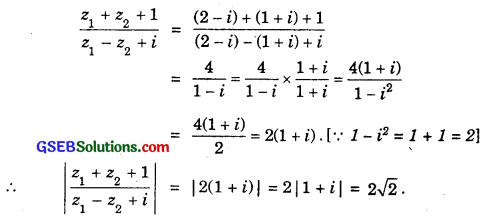
11. If (a + b) = \(\frac{(x+i)^{2}}{2 x^{2}+1}\), prove that a2 + b2 = \(\frac{\left(x^{2}+1\right)^{2}}{\left(2 x^{2}+1\right)^{2}}\).
Solution:
(a + ib) = \(\frac{(x+i)^{2}}{2 x^{2}+1}\) ………………… (1)
Replacing i by – i, we get
a – ib = \(\frac{(x-i)^{2}}{2 x^{2}+1}\) …………………….. (2)
Multiplying (1) and (2), we get
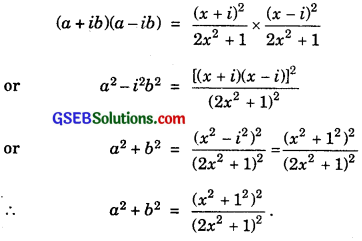
![]()
12. Let z1 = 2 – i and z2 = – 2 + i. Find:
(i) Re\(\left(\frac{z_{1} z_{2}}{z_{1}}\right)\)
(ii) Im\(\left(\frac{1}{z z_{1}}\right)\)
Solution:
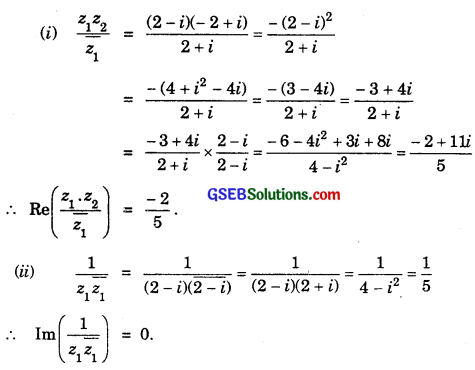
13. Find the modulus and argument of the complex number \(\frac{1 + 2i}{1 – 3i}\).
Solution:
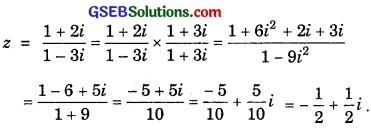
Put r cos θ = – \(\frac{1}{2}\) and r sin θ = \(\frac{1}{2}\).
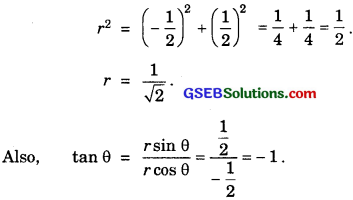
sin θ is +ve and cos θ is -ve.
∴ θ = π – \(\frac{π}{4}\) = \(\frac{3π}{4}\).
∴ |\(\frac{1 + 2i}{1 – 3i}\)| = \(\frac{1}{\sqrt{2}}\) and arg (\(\frac{1 + 2i}{1 – 3i}\)) = \(\frac{3π}{4}\).
![]()
14. Find the real number x and y, if (x – iy)(3 + 5i) is conjugate of – 6 – 24i.
Solution:
Conjugate of – 6 – 24i is – 6 + 24i …………………. (1)
Also, (x – iy)(3 + 5i) = 3x – 5yi2 – 3yi + 5xi
= (3x + 5y) + (5x – 3y)i …………………… (2)
Equating (1) and (2), we get
3x + 5y + (5x – 3y)i = – 6 + 24i
∴ 3x + 5y = – 6
and 5x – 3y = 24
or 3x + 5y + 6 = 0
and 5x – 3y – 24 = 0.

∴ x = 3, y = – 3.
15. Find the modulus of \(\frac{1+i}{1-i}\) = \(\frac{1-i}{1+i}\).
Solution:
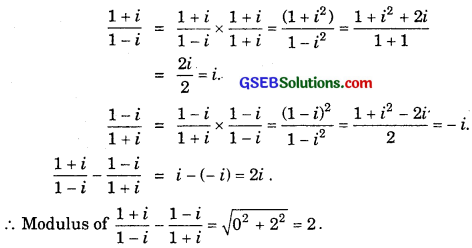
16. If (x + iy)3 = u + iv, then show that \(\frac{u}{x}\) + \(\frac{u}{y}\) = 4(x2 – y2).
Solution:
(x + iy)3 = x3 + 3x2iy + 3x.(iy)2 + (iy)2
= x3 + 3x2yi – 3xy2 – iy3
∴ (x3 – 3xy2) + (3x2y – y3)i = u + iv.
Equating real and imaginary parts, we get
x3 – 3xy2 = u ∴ x2 – 3y2 = \(\frac{u}{x}\) ……………….. (1)
3x2 – y3 = v ∴ 3x2 – y2 = \(\frac{v}{y}\) ………………… (2)
Adding (1) and (2), 4x2 – 4y2 = \(\frac{u}{x}\) + \(\frac{v}{y}\)
∴ \(\frac{u}{x}\) + \(\frac{v}{y}\) = 4(x2 – y2).
![]()
17. If α and β are different complex numbers with |β| = 1, then find |\(\frac{\beta-\alpha}{1-\alpha \beta}\)|.
Solution:
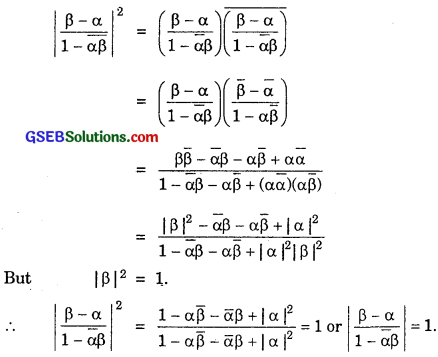
18. Find the number of non-zero integral solutions of the equation |1 – i|x = 2x.
Solution:
|1 – i| = \(\sqrt{1^{2}+(-1)^{2}}\) = \(\sqrt{2}\) = 21/2.
∴ |1 – i|x = (21/2)x = 2x/2.
Since |1 – i|x = 2x, therefore
2x/2 = 2x.
∴ \(\frac{x}{2}\) = x is admissible except x = 0.
⇒ There is no non-zero integral solution. Its solution is x = 0.
19. If (a + ib)(c + id)(e + if)(g + ih) = A + iB, then show that (a2 + b2)(c2 + d2)(c2 + f2) + (g2 + h2) = A2 + B2.
Solution:
(a + ib)(c + id)(e + if)(g + ih) = A + iB ………………. (1)
Replacing i by – i, we get
(a – ib)(c – id)(e – if)(g – ib) = A – iB …………………… (2)
Multiplying (1) and (2), we get
[(a + ib )(a – ib)] [(c + id)(c – id)] [(e + if)(e – if)] [(g + ih)(g – ih)] = (A + iB)(A – iB)
or (a2 – i2b2)(c2 – i2d2)(e2 – i2f2)(g2 – i2h2) = A2 – i2B2
(a2 + b2)(c2 + d2)(e2 + f2)(g2 + h2) = A2 + B2.
(a2 + b2)(c2 + d2)(e2 + f2)(g2 + h2) = A2 + B2. [∵ i2 = – 1]
![]()
20. If (\(\frac{1+i}{1-i}\))m = 1, then find the least integral value of m?
Solution:
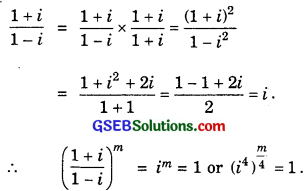
⇒ m is a multiple of 4.
∴ Least value of m = 4.